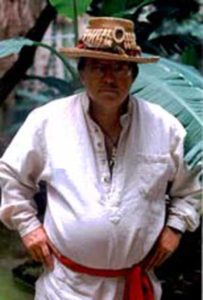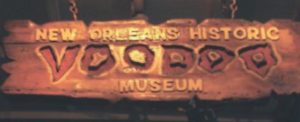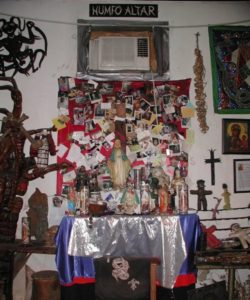NEW ORLEANS HISTORIC VOODOO MUSEUM TIMELINE
1939: Charles Massicot Gandolfo was born.
1972: The New Orleans Historic Voodoo Museum was opened by Charles and Jerry Gandolfo.
2001 (February 27): Charles Gandolfo passed away due to a heart attack.
2001: Management of the museum transitioned to John T. Martin.
2005: Ownership of the museum passed to Jerry Gandolfo.
2005 (August 29): New Orleans was struck by Hurricane Katrina.
2014: John T. Martin passed away due to a heart attack.
FOUNDER/GROUP HISTORY
The Vodou practiced in present-day New Orleans has major roots in both Africa and Haiti (Long 2001, 2016). The earlier African Vodou (which contemporary practitioners refer to as “The Religion”) initially entered Louisiana in the first half of the eighteenth century through the French slave trade that brought thousands of slaves from West Africa (Fandrich 2007). In the early decades of the eighteenth century Catholic nuns arrived to proselytize to the Louisiana slave population, and slave owners were legally required to provide instruction in Roman Catholic doctrine and practice. Over generations the slave population melded traditional African with Roman Catholic beliefs and practices. Haitian Vodou arrived in Louisiana in the wake of the successful slave rebellion in the early 1790s and the violence attending Haitian independence in 1804. Americans began immigrating to Louisiana following the Louisiana Purchase agreement with France in 1803. During the first half of the nineteenth century, some slaves from Central Africa who had initially been brought into states in the northern tier of the South began to appear in New Orleans. They brought with them the practice of Hoodoo, further complicating the cultural mix.
The dominant syncretic Haitian and African Vodou traditions maintain parallel but somewhat separate histories and traditions (Crocker 2011:7).
Members of The Religion who are raised in New Orleans Vodou practice their faith privately and in secret. They create altars in the private spaces of their homes to connect to the ancestors, but they also make offerings in the public spaces of graveyards. Vodouists trained in Haiti conduct ceremonies weekly in private temples and monthly in public spaces. The open nature of their faith allows for converts and public consumption of many rituals.
As, Crocker (2008:24-25) describes the implications for present-day New Orleans:
Presently these two Vodous have come together in the city of New Orleans and now must share more than just a history and a name. Both groups hold spaces such as graveyards and Congo Square sacred. Each also recreates sacred spaces in private and public, creating a web of meanings that intersect one another.
The Voudou scene subsequently has become even more complicated with the advent of the tourism industry, as tourists and the tourist trade mix traditions for commercial purposes (Long 2001). As Crocker (2011:6) describes this scene:
Tourist shops and sites profit from both of these types of Vodou, tapping into the history of The Religion in New Orleans through places and historical figures while marketing with Haitian symbols and terms. They package them as one unified religion while mixing in exotic and exciting elements that neither faith identifies with. Practitioners who sell to and perform for tourists further blur these lines. Tour guides and travel books weave a path through New Orleans space and history that incorporates sacred spaces for both groups of Vodouists. These spheres of tourist and practitioner merge at points along the city, creating layers of overlapping perceptions and experiences of sacred.
The New Orleans Vodou Museum is the product of the confluence of these various traditions.  The museum represents the vision of Charles “Voodoo Charlie” Gandolfo [Image at right] and his younger brother Jerry Gandolfo, who are descended from a Creole family. Both were lifelong residents of New Orleans, but neither was a Voodoo practitioner, although Charles did write on the tradition (Gandolfo 1985). According to family lore, Charles Gandolfo was connected to Voodoo through his great-great-great grandmother. During the 1791 slave rebellion in Haiti, a slave hid members of the Gandolfo family and aided their escape to New Orleans. One of those rescued was the grandmother, who, it turned out, was an eighteenth century Voodoo Queen (The Team n.d.; Tucker 2011).
The museum represents the vision of Charles “Voodoo Charlie” Gandolfo [Image at right] and his younger brother Jerry Gandolfo, who are descended from a Creole family. Both were lifelong residents of New Orleans, but neither was a Voodoo practitioner, although Charles did write on the tradition (Gandolfo 1985). According to family lore, Charles Gandolfo was connected to Voodoo through his great-great-great grandmother. During the 1791 slave rebellion in Haiti, a slave hid members of the Gandolfo family and aided their escape to New Orleans. One of those rescued was the grandmother, who, it turned out, was an eighteenth century Voodoo Queen (The Team n.d.; Tucker 2011).
Charles Gandolfo lived as an artist and hair stylist in New Orleans during the 1970s, owning and operating “The Salon of the Artist.” Looking for profitable ventures, the two brothers decided to establish a Voodoo museum in the city, and Jerry Gandolfo was primarily responsible for gathering the various materials that became the basis for the initial museum collection. Prior to the opening of the museum Voodoo materials were available primarily in “drug stores” in predominantly black, poor neighborhoods. It was the Gandolfo brothers who attempted to reach out to the larger community when their museum opened in 1972. As Jerry Gandolfo describes the initial collection, it was
a hodgepodge of artifacts of varying authenticity: horse jaw rattles, strings of garlic, statues of the Virgin Mary, yards of Mardi Gras beads, alligator heads, a clay “govi” jar for storing souls, and the wooden kneeling board allegedly used by the greatest voodoo queen of all: New Orleans’ own Marie Laveau (Tucker 2011).
The pair was joined by a Voodoo priest, John T. Martin, who worked as a guide at the museum.
DOCTRINES/BELIEFS/RITUALS
The New Orleans Historical Voodoo Museum serves as a museum for tourists, a tourist shop, and a place of worship for local practitioners of The Religion. While religious ceremonies are not held regularly, individual practitioners use the Alter Room for personal worship. On occasion various notables from various traditions have held ceremonies at the museum (Filian 2011:44).
Mambo Sallie Ann Glassman, Santeria priestess Ava Kay Jones, drummer and occultist Louis Martinié, and Voodoo Spiritual Temple founder Oswald Chamani all have done rituals at the New Orleans Historic Voodoo Museum. Gandolfo was among the first to begin the now-popular practice of “mixing and matching” various African diasporic traditions. Yoruba practitioners, Paleros (practitioners of the Kongo-derived Cuban tradition Palo Mayombe), and Spiritualists were welcomed and presented as Voodoo priests. Today many practitioners follow his lead, happily blending Santeria, Haitian Vodou, and other traditions into the practices.
The museum also conducts Voodoo ceremonies on St. John’s Eve (June 23) and Halloween night (October 31) (Alton 2011).
ORGANIZATION/LEADERSHIP
Originally founded by brothers Charles and Jerry Gandolfo in 1972, management passed to John T. Martin after Charles Gandolfo’s death. He had worked with the museum for many years, refers to himself as a Vodou priest, and offers fortune telling services. In 2005, Jerry Gandolfo assumed ownership of the museum. Together, the three men built a growing audience for the museum. Filian (2011:44) estimates that the number of daily visitors increased from thirty in 1972 to 138 in 1999.

The New Orleans Historical Voodoo Museum [Image at right] occupies an extremely small space, consisting of a retail area in the front that is linked by a corridor to two display rooms in the rear. The two rooms and connecting corridor are filled with the diverse items the Gandolfo brothers gathered in addition to offerings left by visiting tourists and Vodou practitioners. Items for sale in the small shop area include books, candles, ingredients for potions, Vodou dolls, Gris gris bags, chicken feet, snake skins, Voodoo Love potion, and New Orleans Voodoo Coffin Kits (Risinger n.d.). In the Gris-gris room there are “bones, paintings, fetish objects and displays” (Crocker 2011:37) This area also includes a large portrait of Marie Laveau. In the Alter Room there is a Humfo Alter [Image at right] (traditional humfos or hounfors are enclosed areas where alters to Vodou deities are kept and offerings to the deities made), tall Saint candles, and a number of statues, including on of the “Virgin Mary with snakes at her feet” (Crocker 2011:38). The alters continually change as tourists and Vodou practitioners leave sacrificial offerings (flowers, candles, cigars, and alcohol are commonplace) for the lwas (spirits) who must be  given honor and sustenance. The Alter Room is particularly interesting since it serves as an attraction for tourists and also a place of worship for local practitioners.The overall sense of the museum space seems to be one of exotic items with limited historical and cultural organization, which is typical of more commercial presentations of Vodou traditions:
given honor and sustenance. The Alter Room is particularly interesting since it serves as an attraction for tourists and also a place of worship for local practitioners.The overall sense of the museum space seems to be one of exotic items with limited historical and cultural organization, which is typical of more commercial presentations of Vodou traditions:
The small museum is crammed with strings of garlic; tombstones from cemeteries; altars laden with beads and small change; African-style drums, statuettes, and masks; candles and horse jaw rattles; a piece of wood that was used by New Orleans’ long-dead Voodoo Queen [Marie Laveau]; and, of course, lots of Voodoo dolls (The Team n.d.)
The appeal to tourist audiences is captured in media pieces that emphasize the exotic and mildly intimidating (Alton 2012):
Surrounded by wooden masks, portraits of prominent Voodoo queens and priests, horse jaw rattles, strings of garlic, alligator heads, human skulls, and clay govis (jars for storing souls), the effect is somewhat frightening.
ISSUES/CHALLENGES
The Voodoo Museum has faced a number of challenges over the course of its history. There has been longstanding resistance to Vodou from secularist skeptic groups (Nickell 2002) and leaders of mainstream religious traditions, although the tourism benefits have muted that resistance. The museum also is situated in a cultural context that contains distinct Vodou traditions that have been in tension with one another. In addition, the museum is supported largely through its tourism audience. And so the museum faces an ongoing problem of identity management and authenticity (Herczog 2003:172).
At a more practical level, the museum is extremely small, two rooms connected by a corridor, but its admission charge is less modest. Still, visitation has increased significantly since its founding as the Vodou theme has become a more prominent theme in New Orleans tourism. That financial stability was seriously undermined by the 2005 hurricane that devastated the city. Anderson (2014) reports that
Locals estimate there were 2,500 to 3,000 voodoo practitioners in New Orleans before Hurricane Katrina, which ravaged the poor, voodoo-heavy neighborhoods of the city, especially the Ninth Ward, forcing residents to relocate permanently across the country and leaving fewer than 300 practitioners in the voodoo community. Many shops went out of business…. Now, nine years after that storm, there are approximately 350 to 400 active practitioners, split between the two dominant strains, Haitian and New Orleans.
Similarly, Tucker (2011) estimates that museum visitation that had reached 120,000 annually fell to 12,000 following Hurricane Katrina. The museum, like the city around it, therefore, faces the challenge of rebuilding for the future (Ulaby 2005).
IMAGES
Image #1: Photograph of Charles Massicot Gandolfo.
Image #2: Photograph of the sign in front of the New Orleans Historic Voodoo Museum.
Image #3: Photograph of the Humfo Alter in the Alter Room.
REFERENCES
Alton, Elizabeth. 2012. “The New Orleans Historic Voodoo Museum.” Entertainment Designer, October 12. Accessed from http://entertainmentdesigner.com/news/museum-design-news/the-new-orleans-historic-voodoo-museum/ on 20 July 2018.
Anderson, Stacey. 2014. “Voodoo Is Rebounding in New Orleans After Hurricane Katrina.” Newsweek, August 25. Accessed from http://www.newsweek.com/2014/09/05/voodoo-rebounding-new-orleans-after-hurricane-katrina-266340.html on 20 July 2018.
Crocker, Elizabeth T. 2008. A Trinity of Beliefs and a Unity of the Sacred: Modern Vodou Practices in New Orleans. MA Thesis, Louisiana State University.
Fandrich, Ina. 2007. “Yorùbá Influences on Haitian Vodou and New Orleans Voodoo.” Journal of Black Studies 37:775-91.
Filan, Kenaz. 2011. The New Orleans Voodoo Handbook. Rochester, VT: Destiny Books.
Gandolofo, Massicot. 1985. Voodoo in South Louisiana Pamphlet. New Orleans, LA: New Orleans Historic Voodoo Museum.
Herczog, Mary. 2003. Frommer’s New Orleans 2003. New York: Wiley Publishing, Inc.
Long, Carolyn Morrow. 2016. “Voudou.” In Encyclopedia of Louisiana, edited by David Johnson. Louisiana Endowment for the Humanities. Accessed from http://www.knowlouisiana.org/entry/voudou on 20 July 2018.
Long, Carolyn Morrow. 2001. Spiritual Merchants: Religion, Magic and Commerce. Knoxville, TN: University of Tennessee Press.
Nickell, Joe. 2002. “Voodoo in New Orleans.” Skeptical Inquirer 26, January/February. Accessed from https://www.csicop.org/si/show/voodoo_in_new_orleans on 20 July 2018.
Pope, John. 2014. “John T. Martin, Python Fancier Who Once Ran the New Orleans Historic Voodoo Museum, Dies at 72.” The Times-Picayune, December 2. Accessed from https://www.nola.com/entertainment/index.ssf/2014/12/john_t_martin_a_python_fancier.html on 13 July 2018.
Risinger, Nathan. n.d. “New Orleans’ Historic Voodoo Museum: A snapshot of the “real” history of New Orleans.” Accessed from https://www.atlasobscura.com/places/new-orlean-s-historic-voodoo-museum on 20 July 2018.
The Team. n.d. “Voodoo Museum.” RoadsideAmerica.com. Accessed from https://www.roadsideamerica.com/story/16770 on 13 July 2018 on 20 July 2018.
Tucker, Abigail. 2011. “The New Orleans Historic Voodoo Museum.” Smithsonian Magazine, June. Accessed from https://www.smithsonianmag.com/arts-culture/the-new-orleans-historic-voodoo-museum-160505840/ on 20 July 2018.
Ulaby, Neda. 2005. “Katrina Disperses New Orleans’ Voodoo Community.” NPR, October 21. Accessed from https://www.npr.org/templates/transcript/transcript.php?storyId=4967315 on 20 July 2018.
Post Date:
23 July 2018
